Study Guide
![]() Print (will print without answers)
Print (will print without answers)
To print with the answers, first select Expand All, then print
Section 4: Sample Multiple-Choice Questions
WEST–E Traffic Safety (043)
The sample test questions in this study guide are designed to give you an introduction to the nature of the questions included in the Washington Educator Skills Tests—Endorsements (WEST–E). They represent the various types of questions you may expect to see on an actual test in this test field; however, they are not designed to predict your performance on the test as a whole.
Work through the sample questions carefully before referring to the answers. The correct response and test objective being assessed are provided for each question. When you are finished with the sample questions, you may wish to review the test objectives and descriptive statements provided in the test framework for this test field.
In addition to reading and answering the sample questions, you should also utilize the following preparation materials available in this study guide:
- Read Section 2: WEST–E Test-Taking Strategies to understand how test questions are designed to measure specific test objectives and to learn important test-taking strategies for the day of the test.
- Review Section 3: Test Summary and Framework to familiarize yourself with the structure and content of the test. This section contains general testing information as well as the percentage of the total test score derived from each content domain described in the test framework.
Practice Questions
Driving Regulations and Responsibilities
Objective 0001: Understand regulations and responsibilities related to the driver license, vehicle ownership, vehicle registration, and traffic violations.
1. A holder of an intermediate driver license is driving at 3:00 a.m. Having which of the following passengers in the car would satisfy the restriction on this type of license?
- a neighbor who is 27 years old and a licensed driver
- a sibling who is 21 years old and a licensed driver
- an uncle who is 22 years old and a licensed driver
- a driving instructor who is 24 years old and a licensed driver
- Enter to expand or collapse answer.Answer expanded
- Correct Response: A.
2. When a car owner sells the vehicle to a private party, the seller is responsible for which of the following actions?
- transferring ownership of the car in person at the licensing office
- signing a written agreement to cover the costs of any needed repairs for a year after the sale
- obtaining new license plates for the buyer before turning over the car
- removing the car's license plates before returning them or transferring them to another vehicle
- Enter to expand or collapse answer.Answer expanded
- Correct Response: D.
3. A driver with a regular license has received a first ticket for a moving violation. Which of the following actions is the driver required to take?
- hiring an attorney for representation
- complying with instructions on the ticket within 15 days
- scheduling a date to appear in court
- waiting for a letter from the Washington Department of Licensing
- Enter to expand or collapse answer.Answer expanded
- Correct Response: B.
Objective 0002: Demonstrate knowledge of vehicle equipment, controls, indicators, safety devices, and reference points.
4. Use the diagram below to answer the question that follows.
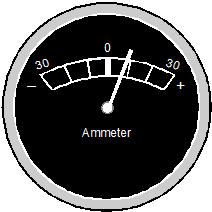
The dashboard gauge is an ammeter which is a measuring scale that spans from negative thirty on the left to positive thirty on the right with zero as the midpoint. The needle of the ammeter indicates positive ten.
The dashboard gauge above indicates the:
- battery's electrolyte level.
- time remaining before the battery should be replaced.
- current state of the battery's charge and overall condition.
- degree to which the battery is charging or discharging.
- Enter to expand or collapse answer.Answer expanded
- Correct Response: D.
5. A switch allows the driver of a car to inactivate the door handles of all passenger doors so that none of the doors can be opened from the inside. This feature is designed primarily to prevent:
- forced or unwanted entry into the car.
- passengers from distracting the driver.
- young children from falling out of the car.
- doors from opening due to mechanical failure.
- Enter to expand or collapse answer.Answer expanded
- Correct Response: C.
6. A driver should use cruise control only when traveling on a:
- rural route with few intersections.
- multilane highway with light traffic.
- city street with synchronized traffic lights.
- two-lane mountain road with turnout areas.
- Enter to expand or collapse answer.Answer expanded
- Correct Response: B.
7. Which of the following automobile safety devices reduces the severity of whiplash caused by a rear-end collision?
- seat headrests
- collapsible steering wheel column
- antilock brakes
- automated emergency braking
- Enter to expand or collapse answer.Answer expanded
- Correct Response: A.
Objective 0003: Demonstrate knowledge of procedures related to preoperative vehicle inspections, starting, parking, and stopping.
8. Which of the following signals is most likely to indicate that a vehicle is in need of wheel balancing?
- The vehicle shakes at 50 mph.
- The steering wheel has excessive free play.
- There is a constant grinding sound coming from the front wheels.
- The car corners poorly, even at low speeds.
- Enter to expand or collapse answer.Answer expanded
- Correct Response: A.
9. Which of the following problems is indicated by tires whose tread is worn along the outside edges but not in the middle?
- The tires are underinflated.
- The car's front end needs an alignment.
- The tires are overinflated.
- The driver has been cornering at excessive speeds.
- Enter to expand or collapse answer.Answer expanded
- Correct Response: A.
10. Which of the following noises most likely indicates that a car has a mechanical problem?
- a soft ticking that occurs immediately after the car is first started
- a high-pitched squeal after the car starts and begins to accelerate
- whistling from the top of the car when it is traveling at high speeds
- noticeably louder road noise after the installation of winter tires
- Enter to expand or collapse answer.Answer expanded
- Correct Response: B.
11. After starting the engine, a driver should take which of the following steps first?
- checking gauges and warning lights
- disengaging the parking brake
- shifting the gear selector into "Drive"
- pumping the accelerator
- Enter to expand or collapse answer.Answer expanded
- Correct Response: A.
Driving Safely
Objective 0004: Demonstrate knowledge of safe driving habits and techniques.
12. Use the diagram below to answer the question that follows.
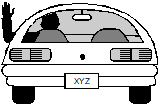
The driver is extending his or her left arm out of the window, bending the elbow at 90 degrees with the hand pointed up and the palm pointed forward.
The hand signal shown in the diagram is used to indicate the driver's intention to:
- turn left.
- turn right.
- reduce speed.
- stop.
- Enter to expand or collapse answer.Answer expanded
- Correct Response: B.
13. A driver likes to accelerate quickly when traffic lights turn green and often comes to abrupt stops at stoplights and stop signs. A friend suggests that the driver should consider accelerating slowly and smoothly when traffic lights turn green and coming to long gradual stops at stoplights and stop signs. Following the friend's suggestion would be most effective in reducing:
- travel time.
- tire wear.
- transmission repairs.
- fuel consumption.
- Enter to expand or collapse answer.Answer expanded
- Correct Response: D.
14. When entering an interstate highway from the acceleration lane, a driver should use which of the following techniques to merge safely into traffic?
- stopping until signaled by another driver to enter traffic
- driving across lanes of traffic to reach the farthest left lane
- accelerating gradually while visually checking for a gap in traffic
- matching the speed of traffic and quickly entering the right-hand lane
- Enter to expand or collapse answer.Answer expanded
- Correct Response: C.
15. A driver would be required to use emergency flashers under which of the following circumstances?
- when encountering brief periods of reduced visibility
- when traveling in inclement weather conditions
- when signaling a sudden change in direction
- when changing a tire on the side of a road
- Enter to expand or collapse answer.Answer expanded
- Correct Response: D.
Objective 0005: Demonstrate knowledge of procedures used in operating a vehicle on public roadways.
16. Use the diagram below to answer the question that follows.

Three cars are traveling on a two-lane road. Car X who is in the left lane is attempting to pass Car Y in the right lane. Car X and Car Z are both in the left lane travelling towards each other head on.
Car X has moved into the lane normally used by oncoming traffic and is attempting to pass Car Y, when Car Z unexpectedly comes into view. Which of the following is the safest procedure for the driver of Car X to take?
- Move farther to the left into the shoulder of the oncoming lane.
- Accelerate in an attempt to pass Car Y before reaching Car Z.
- Apply the brake and attempt to pull back in behind Car Y.
- Flash headlights and sound the horn to warn the driver of Car Z.
- Enter to expand or collapse answer.Answer expanded
- Correct Response: C.
17. Which of the following best describes the regulations concerning the use of sidewalks by bicyclists?
- Bicyclists may use sidewalks but must yield the right of way to pedestrians.
- Bicyclists are restricted from riding on sidewalks during daylight hours.
- Bicyclists may use sidewalks only when no pedestrians are present on the sidewalk.
- Only bicyclists under the age of 12 and adults accompanying them may use sidewalks.
- Enter to expand or collapse answer.Answer expanded
- Correct Response: A.
18. A driver should use a sharp blast of the horn in which of the following situations?
- The driver is exiting a parking garage and entering a residential street.
- The driver is passing a bicyclist who is riding on the right of the roadway.
- The driver is warning another driver that their vehicles are in danger of colliding.
- The driver is encouraging a slower driver to move to the right to let others pass.
- Enter to expand or collapse answer.Answer expanded
- Correct Response: C.
19. When following a large truck on a multilane road, a driver of a passenger vehicle should take which of the following actions?
- following at a two-second sight distance to get closer to the truck's mirrors
- pulling up alongside the truck in the left lane and matching the truck's speed
- increasing following distance to remain outside the truck's no-zones or blind spots
- gripping the steering wheel tightly in anticipation of wind gusts caused by the truck
- Enter to expand or collapse answer.Answer expanded
- Correct Response: C.
Objective 0006: Understand roadway signs, markings, signals, and controls.
20. Use the diagram below to answer the question that follows.

There is a road sign with two symbols. The symbol on the left is a semi-circle centered on a small, solid circle with three arrows pointing outward from the semi-circle indicating exits at twelve o'clock, nine o'clock, and six o'clock. "Left Lane" is written under the symbol on the left. The sign on the left is a half-circle with two arrows pointing outward from the half-circle indicating exits at three o'clock and twelve o'clock. "Right Lane" is written under the symbol on the right.
The sign in the diagram is most likely to be displayed at:
- an expressway entrance.
- a roundabout entrance.
- an expressway exit.
- a roundabout exit.
- Enter to expand or collapse answer.Answer expanded
- Correct Response: B.
21. Which of the following roadway markings indicates one-way traffic with passing allowed?
- single solid white lines
- single solid yellow lines
- single dotted white lines
- single dotted yellow lines
- Enter to expand or collapse answer.Answer expanded
- Correct Response: C.
22. Use the images below to answer the question that follows.

The first sign indicates merging traffic from the right. The second sign indicates a pedestrian crossing area. The third sign indicates two-way traffic.
- The primary purpose of these signs is to:
- inform drivers of traffic laws that they must obey.
- alert drivers to potential hazards or changing traffic conditions.
- indicate the actions a driver should take in certain traffic situations.
- direct drivers to interstate routes, intersections, and service areas.
- Enter to expand or collapse answer.Answer expanded
- Correct Response: B.
23. A driver who is traveling in the express lane of an interstate highway sees a digital sign overhead showing an illuminated steady yellow "X." In this situation, the driver should follow which of the following reversible-lane procedures?
- continuing to drive in the express lane until reaching a convenient exit
- reducing speed to 35 miles per hour in anticipation of exiting the highway
- merging into the right lane of traffic immediately without reducing speed
- moving out of the express lane as soon as it is safe to do so
- Enter to expand or collapse answer.Answer expanded
- Correct Response: D.
Objective 0007: Demonstrate knowledge of the driving techniques used in given situations.
24. A car has begun to skid on slippery pavement. The rear end of the car is sliding to the left. Which of the following procedures would be most effective for the driver to use to control the skid?
- Steer to the left if the car has front-wheel drive. Steer to the right if the car has rear-wheel drive.
- Steer to the right if the car has front-wheel drive. Steer to the left if the car has rear-wheel drive.
- Steer to the left whether the car has front-wheel drive or rear-wheel drive.
- Steer in the direction the car needs to go whether the car has front-wheel drive or rear-wheel drive.
- Enter to expand or collapse answer.Answer expanded
- Correct Response: C.
25. In which of the following situations should a driver be prepared to apply the brakes?
- passing a vehicle on the right on a multilane roadway
- maintaining a 5-second following distance behind another vehicle
- approaching a signal light in a busy intersection
- traveling on a divided roadway that passes through several hills
- Enter to expand or collapse answer.Answer expanded
- Correct Response: C.
26. Use the diagram below to answer the question that follows.
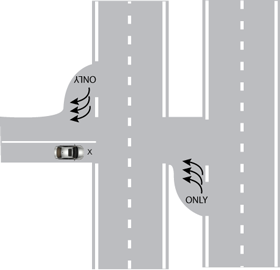
Car X is stopped on a two-lane side road that is perpendicular to a multilane highway. The multilane highway is separated by a median and joined by a median strip directly ahead of Car X. The highway has two lanes traveling south and two lanes traveling north. Two turn lanes are marked with the word "Only" and three arrows indicating the direction of the turn. On the southbound side of the highway, the turn-lane arrows point toward the right to enter the two-lane road. On the northbound side of the highway, the arrows point left to enter the median strip between the northbound and southbound lanes.
Driver X wants to turn left from the two-lane side road onto the northbound side of the multilane highway. First, Driver X activates the turn signal. Next, Driver X checks for southbound traffic. After confirming that the southbound lanes are free of traffic, which of the following steps should Driver X take next?
- accelerating rapidly across both southbound lanes
- checking the northbound turn lane for oncoming traffic
- waiting for a break in traffic traveling north and south
- checking the southbound turn lane for moving vehicles
- Enter to expand or collapse answer.Answer expanded
- Correct Response: B.
Risk Factors and Risk Management
Objective 0008: Demonstrate knowledge of physical, social, psychological, and emotional issues related to driving.
27. A driver is legally permitted to hold a cell phone next to his or her ear while driving for the purpose of:
- summoning an emergency vehicle to the scene of an accident.
- alerting a radio station about traffic conditions affecting commuters.
- requesting or receiving instructions for a commercial delivery.
- communicating with a family member or coworker.
- Enter to expand or collapse answer.Answer expanded
- Correct Response: A.
28. Driver A observes as Driver B cuts off Driver C during an unsafe lane change and as Drivers B and C exchange angry gestures. Which of the following responses by Driver A would most likely help avoid becoming involved in a road rage incident?
- sounding the horn or flashing the headlights while passing Drivers B and C
- maintaining eye contact with Drivers B and C to signal that their actions are being observed
- making an angry gesture at Driver B to demonstrate agreement with Driver C's reaction
- slowing down or changing lanes to add distance between the vehicle and those of Drivers B and C
- Enter to expand or collapse answer.Answer expanded
- Correct Response: D.
29. Which of the following actions by a driver would most likely decrease the driver's awareness of critical traffic sounds?
- wearing headphones over both ears
- listening to the car radio at low volume
- conversing with a child who is in the backseat
- using a car speakerphone connected to a hands-free device
- Enter to expand or collapse answer.Answer expanded
- Correct Response: A.
30. Which of the following actions is most likely to reduce a driver's fatigue?
- limiting driving time to a maximum of 10 hours per day
- traveling between the hours of midnight and 6:00 AM
- drinking caffeinated beverages before beginning a trip
- taking a 15-minute powernap between two 8-hour trips
- Enter to expand or collapse answer.Answer expanded
- Correct Response: A.
Objective 0009: Understand alcohol and other drugs and the effects of alcohol and other drugs on driving.
31. Which of the following is the most common adverse effect of taking barbiturates while driving?
- hallucinations
- impaired vision
- slower reaction times
- violent emotional responses
- Enter to expand or collapse answer.Answer expanded
- Correct Response: C.
32. In Washington State, the legal blood alcohol limit for adults while driving is:
- 0.05.
- 0.08.
- 0.10.
- 0.25.
- Enter to expand or collapse answer.Answer expanded
- Correct Response: B.
33. Marijuana use is most likely to impair a person's ability to drive safely by:
- causing double vision.
- triggering seizures.
- enhancing hypervigilance.
- slowing reaction times.
- Enter to expand or collapse answer.Answer expanded
- Correct Response: D.
34. A law enforcement officer conducts a traffic stop on a vehicle for suspicion of driving under the influence. The law enforcement officer asks the driver, who is 27 years old and has never been arrested, to take a blood alcohol content (BAC) breath test, but the driver refuses. The driver's refusal will most likely result in which of the following penalties?
- seizure of the vehicle by the police
- incarceration for at least two years
- license suspension for at least one year
- moving violation with an associated fine
- Enter to expand or collapse answer.Answer expanded
- Correct Response: C.
Objective 0010: Demonstrate knowledge of procedures for assessing and managing risk in driving situations.
35. A person is most likely to experience loss of visibility due to glare when driving:
- west, shortly after sunset.
- when the sun is directly overhead.
- east, in the early morning hours.
- in the mountains at any time of day.
- Enter to expand or collapse answer.Answer expanded
- Correct Response: C.
36. When driving on an icy road it is most important to reduce speed and:
- keep one foot on the brake and the other foot on the accelerator.
- put the car in neutral when descending a hill.
- downshift into a lower gear before entering a curve.
- avoid sudden changes in direction or speed.
- Enter to expand or collapse answer.Answer expanded
- Correct Response: D.
37. Use the diagram below to answer the question that follows.
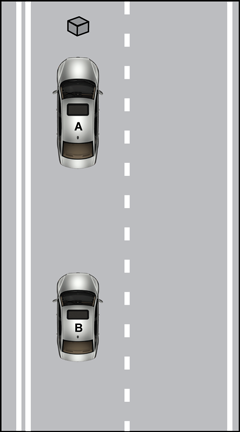
Car A and Car B are both in the left passing lane. Car A is about a car-length ahead of Car B. An object appears a few feet in front of Car A.
Driver B is traveling at sixty-five miles per hour in the passing lane on the interstate highway when Driver A, who is traveling 4 seconds ahead of Driver B, suddenly stops to avoid hitting a large object. Which of the following actions should Driver B take to avoid a collision with Driver A?
- determining the effectiveness of braking by calculating a safe following distance
- increasing speed and passing Driver A on the left shoulder
- checking for traffic in the right lane before quickly changing lanes to avoid Driver A
- pumping the brakes while bracing for a possible collision
- Enter to expand or collapse answer.Answer expanded
- Correct Response: C.
Objective 0011: Demonstrate knowledge of procedures used to deal with emergencies in driving situations.
38. A driver who is trying to park his car in the parking lot of a shopping center hits the rear of a parked car. On examining the parked car, the driver sees that the accident has scratched the rear bumper of the parked car. The owner of the parked car is not present. Which of the following best describes the obligation of the driver?
- Call the manager of the shopping center to report the accident.
- Attempt to locate the owner of the car in the shopping center.
- Notify the driver's insurance company.
- Leave a note, including contact information, on the parked car.
- Enter to expand or collapse answer.Answer expanded
- Correct Response: D.
39. A driver suddenly notices that the vehicle's temperature gauge indicates that the engine is overheating. After pulling over to a safe location, the driver should take which of the following actions next?
- turning off the engine
- adjusting the air conditioner
- adding water to the radiator
- monitoring the temperature gauge
- Enter to expand or collapse answer.Answer expanded
- Correct Response: A.
40. Use the diagram below to answer the question that follows.
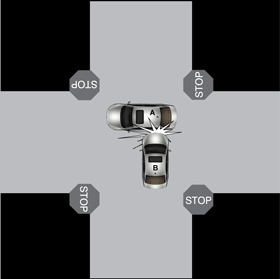
At a four-way stop intersection, Driver A's vehicle is hit on the rear passenger door by Driver B's vehicle, resulting in minor damage to both vehicles. Driver A and Driver B are uninjured. Which of the following steps should Driver A and Driver B take first?
- photographing the damage done to each vehicle
- exchanging names and insurance information
- calling the local police to report the accident
- moving the vehicles out of the intersection
- Enter to expand or collapse answer.Answer expanded
- Correct Response: D.